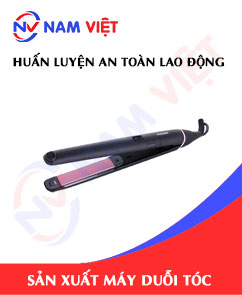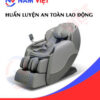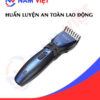Occupational Safety Training in Hair Straightener Manufacturing
99,000 ₫
Note: The above price is calculated for one person, the price may fluctuate depending on the number of trainees participating in the course and depending on market movements. For more accurate pricing support, please refer to the quotation table or contact our consulting staff directly.
Occupational safety is an important issue in hair straightener manufacturing factories and needs to be addressed promptly to ensure the health and safety of workers, and to enhance the reputation of businesses. The Occupational safety training course is one of the effective solutions to raise awareness about accident prevention for workers participating in hair straightener manufacturing.
Table of Contents
Toggle1. Overview of Hair Straighteners
a. What is a hair straightener?
A hair straightener, also known as a flat iron or hair curler, is an electronic device used to straighten or curl hair. It is commonly used in hair salons and is also a popular product for home use.
Hair straighteners typically have two heated plates made of metal or ceramic attached to hinges to straighten hair. They operate by converting electrical energy into heat to straighten or curl the hair.

b. Types of machinery used in hair straightener production
The types of machinery involved in hair straightener production include:
- Metalworking machines: used to cut, bend, punch, press, mill, and drill metal to create small parts of hair straighteners such as metal rods, buttons, cord hooks, etc.
- Plastic injection machines: used to produce plastic parts of the hair straightener, such as handles, protective covers, casings, etc.
- Molding machines: used to create molds for the plastic parts of the hair straightener.
- Welding machines: used to weld metal and plastic components of the hair straightener together.
- Wire cutting machines: used to cut and attach electrical wires to the hair straightener.
- Quality control machines: used to test the features, quality, and performance of hair straighteners before packaging and shipping.

c. Hair straightener manufacturers in Vietnam
Some well-known hair straightener brands in Vietnam include:
- Kemei: A brand known for shavers and hair dryers, also producing high-quality hair straighteners.
- Philips: A Dutch brand that has been in the Vietnamese market for a long time. Philips products are generally high-quality and attractively designed.
- Panasonic: A Japanese brand present in Vietnam for many years, offering quality products to consumers.
- Gemei: A Chinese brand known for high-quality and affordable products.
- Babyliss: A French brand available in Vietnam, offering well-designed and high-quality hair straighteners.
- Remington: An American brand present in Vietnam, known for high-quality products highly rated by users.
d. Specific roles in a hair straightener manufacturing factory
Group 1
- Executive director, deputy executive director, department heads in the hair straightener manufacturing factory.
Group 2
- Safety officers: manage safety in the factory, design safety procedures, monitor and enforce staff compliance with safe working practices.
Group 3
- Component fabrication: The parts of hair straighteners, including casing, control unit, heating elements, and other components, are manufactured by factory machinery.
- Assembly: Components are assembled and each product’s quality is inspected.
- Quality control: Each product is inspected to ensure quality before being released to the market.
- Packing and shipping: Products are packed and prepared for delivery to retailers or direct customers.
- Maintenance and repair: The maintenance team ensures products are maintained and repaired if necessary, keeping them fully operational.
Group 4
- Office, service, sales, and marketing roles.
- Production management, quality management, human resources management, materials management, financial and accounting management.
- Design: The design team creates new product models based on customer requirements, safety standards, and aesthetics.
- Research and development: This team researches new technologies to enhance product features.

2. Overview of occupational safety training for hair straightener production
This article focuses on issues related to Group 3 because Group 3 is directly involved in the production process and is exposed to the highest occupational safety risks. For more information about other groups, see here.
a. What is Group 3 occupational safety training?
- Group 3 occupational safety training consists of sessions that raise awareness on preventing workplace accidents for workers.
- The training course helps workers recognize and avoid hazards, minimizing the risk of workplace accidents.
REGISTER FOR OCCUPATIONAL SAFETY TRAINING
b. Training duration
Initial occupational safety training:
- Total training time is at least 24 hours, including exam time.
- 8 hours of theory on safety policies and labor hygiene regulations
- 8 hours of theory on basic occupational safety and hygiene knowledge
- 4 hours of theory on specialized training content
- 2 hours of practical training on specialized content
- 2 hours of final theory examination
The safety training center schedules sessions based on workers’ availability. Typically, there are 6 sessions over 3 days, provided the company can allocate continuous training time.
Periodic occupational safety training:
- Before the occupational safety card expires, workers who want to renew it must undergo periodic occupational safety training with training time of at least 50% of the initial training duration.
Explanation: The total duration of periodic occupational safety training is at least 12 hours, including exam time. After completing the training and passing the exam, workers will have their occupational safety card renewed.
c. Training content
| No. | TRAINING CONTENT | TRAINING DURATION (HOURS) | |||
| Total | Including | ||||
| Theory | Practice | Examination | |||
| I | Policies and occupational safety and hygiene regulations | 8 | 8 | 0 | 0 |
| 1 | Overview of legal documents on occupational safety and hygiene. | 6 | 6 | ||
| 2 | Standards and technical regulations on occupational safety and hygiene. | 1 | 1 | ||
| 3 | Specific regulations of government authorities on occupational safety and hygiene when constructing, expanding, or renovating facilities and inspecting machinery, equipment, materials, and hazardous substances. | 1 | 1 | ||
| II | Basic knowledge of occupational safety and hygiene | 8 | 8 | 0 | 0 |
| 1 | Basic knowledge of hazards in the workplace. | 4 | 4 | ||
| 2 | Methods to improve working conditions. | 1 | 1 | ||
| 3 | Safety culture in production and business. | 1 | 1 | ||
| 4 | Rights and obligations of employers and employees; policies on occupational safety and hygiene; roles of safety officers. | 1 | 1 | ||
| 5 | Safety rules, signs, use of protective equipment, first aid skills, and occupational disease prevention. | 1 | 1 | ||
| III | Specialized training content | 6 | 4 | 2 | 0 |
| Comprehensive knowledge of machinery, devices, hazardous substances; risk analysis, management, and safe working procedures with machines and substances requiring strict safety and hygiene measures. | 6 | 4 | 2 | ||
| IV | Final occupational safety assessment | 2 | 2 | 0 | 0 |
| Total | 24 | 22 | 2 | ||
See more training content of all 6 groups
d. Occupational safety card
After completing occupational safety training and passing the examination, workers are issued an occupational safety card (commonly called Group 3 occupational safety certificate).
The Group 3 safety card shows the worker’s name, date of birth, job, and working environment, along with training duration, red stamp, and signature confirming completion of the training.
According to Clause 2 of Article 24, Decree 44/2016/ND-CP, there are two cases:
- If the employer and employee have a labor contract, the employer must sign and stamp the safety card for the Group 3 trainee after completing training from a certified safety training unit and passing the exam.
- If the worker is freelance or seasonal without a labor contract, the training unit must sign and stamp the safety card after completing training and passing the exam.

3. Identifying hazards affecting workers during hair straightener production
During hair straightener production, potential hazards that may affect workers’ health include:
- Fire and explosion risk: Using chemicals and oils can cause fire or explosion hazards, especially if fire safety regulations are not followed.
- Burn risk: Hair straighteners operate at high temperatures, which can cause burns during production.
- Machinery accident risk: Workers may suffer accidents when operating machinery, especially without proper personal protective equipment such as helmets, safety glasses, gloves, etc.
- Electric shock risk: Poorly maintained or improperly insulated electrical equipment may cause electric shocks.
- Back and neck pain risk: Workers often stand or sit for long periods while operating machinery, potentially causing back and neck pain.
- Eye strain risk: Frequent use of machinery may affect workers’ vision, particularly if factory lighting safety regulations are not observed.
- Hearing damage risk: Noise from machinery may cause ear discomfort or hearing damage.
4. Common Workplace Accidents for Workers Producing Hair Straighteners
Common workplace accidents that may occur during the production of hair straighteners include:
- Fire and explosion: During production, chemicals, especially preservatives and plasticizers, can create high temperatures and are flammable. In addition, high voltage can also cause fire or explosion hazards for electronic devices such as production machinery for hair straighteners.
- Injury from trauma: Accidents related to trauma can occur due to mechanical production equipment, cutting tools, machinery, hand tools, and electronic devices in the factory. Sharp metal materials, drill bits, cutting knives, screwdrivers, screws, and other tools can cause injuries to workers.
- Burns: Due to high temperatures during hair straightener production, materials such as plastic, metal, rubber, and other chemicals may pose burn hazards to workers.
- Mental health: Work pressure, continuous work in noisy and dusty environments can cause stress and negatively affect workers’ mental health.
- Respiratory diseases: Inhaling polluted air in the hair straightener production factory can lead to respiratory issues for workers, including bronchitis, pneumonia, asthma, and allergies.
- Environmental factor impacts: Factories producing hair straighteners need to pay attention to environmental factors such as temperature, humidity, cleanliness, and lighting to ensure worker safety and health.

5. Safety Measures When Participating in Hair Straightener Production
To ensure worker safety during hair straightener production, the following safety measures should be implemented:
- Ensure the use of protective equipment such as helmets, masks, safety glasses, gloves, protective clothing, anti-slip shoes, etc.
- Occupational safety training for employees on safety procedures and regulations, including equipment usage, equipment cleaning, repair, and maintenance processes.
- Conduct periodic inspections of production equipment to ensure compliance with safety and quality standards.
- Perform regular maintenance checks on machinery to ensure safe and proper operation.
- Minimize electrical hazards by using voltage converters and ensuring electrical safety.
- Use appropriate cleaning agents and chemicals according to instructions to ensure employee safety.
- Store and handle materials properly to avoid hazards for users.
- Strictly monitor compliance with safety regulations and promptly address arising issues.
- Periodically conduct workplace environment monitoring in factories to collect and analyze harmful factors affecting workers, then adjust to reduce risks and prevent occupational diseases.
6. Benefits of Occupational Safety Training for Hair Straightener Production
An Toan Nam Viet provides businesses with the following benefits after completing occupational safety training courses in accordance with Decree 44/2016/ND – CP on occupational safety and hygiene:
- Workers can identify potential workplace hazards and take preventive measures to avoid accidents.
- Businesses can establish risk prevention measures in production, operation, and maintenance processes.
- Minimize costs associated with labor safety risks.
- Uninterrupted production increases labor productivity and product quality.
- Ensure compliance with labor safety regulations, avoiding legal risks.
- Enhance reputation and professionalism, improving the company’s brand image.
Nam Viet’s training courses provide solutions to prevent and mitigate external hazards affecting individuals, helping them avoid injuries or, in severe cases, fatalities.
REGISTER FOR OCCUPATIONAL SAFETY TRAINING SERVICES
7. Customer Feedback After Completing Occupational Safety Training for Hair Straightener Production
An Toan Nam Viet has many years of experience supporting numerous businesses in Vietnam in general and southern provinces in particular. This responsibility is extremely valuable, which is why our Occupational Safety Training is increasingly professional. Our growth is driven by positive feedback and suggestions from partner businesses. Below are testimonials from clients we have served.
Bac Nam E&C Investment and Construction Joint Stock Company
“My first experience with An Toan Nam Viet’s service surprised me due to the 24/7 support from the consulting team. The class organization was very fast and convenient for our company. Thank you very much for Nam Viet’s service!”
Hoa Dat Construction and Trading Joint Stock Company
“Nam Viet’s service has greatly helped us simplify labor safety and complete safety documentation for work processes. The consulting team is enthusiastic and timely in addressing our questions. 5 stars for Nam Viet.”
See more customer interviews after using the service from An Toan Nam Viet
8. Occupational Safety Training Capability of An Toan Nam Viet
An Toan Nam Viet is a reputable and high-quality occupational safety training center in Vietnam, providing continuous training at production workshops, factories, or construction sites across the country (63 provinces in Vietnam).
REGISTER FOR OCCUPATIONAL SAFETY TRAINING SERVICES
Occupational Safety Training License
- An Toan Nam Viet has been inspected and certified by the Department of Safety under the Ministry of Labor, Invalids and Social Affairs, confirming our eligibility to conduct occupational safety and hygiene training, strengthening our training capabilities.

Training Materials and Lectures
- Before being used in safety training courses, all materials are reviewed to ensure accurate knowledge transfer and practical effectiveness.
- Instructors’ teaching methods are standardized according to An Toan Nam Viet standards, developed by occupational safety experts to maximize knowledge absorption for trainees.
Facilities
- Controlling classroom factors affecting training enhances teaching efficiency and learning outcomes.
- Our training facilities include spacious classrooms meeting standards for area, lighting, and training equipment.
9. Nationwide Reputable and High-Quality Safety Training Center
At An Toan Nam Viet, we prioritize professional occupational safety training. Teaching workers how to protect themselves is part of nation-building.
To ensure effective training, we meticulously prepare every detail, from tools and teaching equipment to curricula, materials, sound, and lighting.
Our instructors are experts with years of experience, including research on hazards across industries and prevention methods.
Lectures are practical, vividly presented, and easy to understand, enabling workers to comfortably absorb knowledge. Content strictly adheres to Decree 44/2016/ND-CP.
Trainees learn many hazard prevention measures and self-protection methods, applying them appropriately in their work.
Our training center proudly provides professional, reputable occupational safety training with the following advantages:
- Competitive training costs with ensured quality.
- Flexible training schedules aligned with company production.
- Fast and legally compliant certification procedures.
- Instructors with many years of professional experience.
- Controlled classroom environment enhances teaching efficiency and knowledge absorption.
- Lectures tailored to enterprise safety requirements.
- An Toan Nam Viet works diligently and professionally to provide fast and accurate support to clients.

10. Additional References for Occupational Safety Training in Hair Straightener Production
- Occupational Safety Materials for Hair Straightener Production
- Full Set of Occupational Safety Training Materials
- Occupational Safety Training Test Materials
- Occupational Safety Training Curriculum for Hair Straightener Production
- Occupational Safety Multiple-Choice Test for Hair Straightener Production
1 review for Occupational Safety Training in Hair Straightener Manufacturing
No comments yet















namchinh.haiphong341
Dịch vụ huấn luyện an toàn lao động rất tốt nhé!